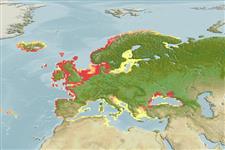Common names from other countries
Environment: milieu / climate zone / depth range / distribution range
Écologie
; saumâtre; profondeur 0 - 50 m (Ref. 434). Subtropical, preferred 11°C (Ref. 107945); 74°N - 23°N, 16°W - 44°W
Northeast Atlantic and the Mediterranean.
Length at first maturity / Taille / Poids / Âge
Maturity: Lm ? range ? - ? cm Max length : 8.9 cm TL mâle / non sexé; (Ref. 434)
Life cycle and mating behavior
Maturité | Reproduction | Frai | Œufs | Fécondité | Larves
Members of the order Decapoda are mostly gonochoric. Mating behavior: Precopulatory courtship ritual is common (through olfactory and tactile cues); usually indirect sperm transfer.
Fischer, W., G. Bianchi and W.B. Scott (eds.). 1981. (Ref. 434)
Statut dans la liste rouge de l'IUCN (Ref. 130435: Version 2024-1)
statut CITES (Ref. 108899)
Not Evaluated
Not Evaluated
Utilisations par l'homme
Pêcheries: commercial
FAO - pêcheries: landings, species profile | FishSource | Sea Around Us
Outils
Sources Internet
Estimates based on models
Preferred temperature
(Ref.
115969): 8.6 - 14, mean 10.5 (based on 410 cells).
Résilience
Faible, temps minimum de doublement de population : 4,5 à 14 années (K=0.09-0.11).
Vulnérabilité
Moderate vulnerability (43 of 100).
